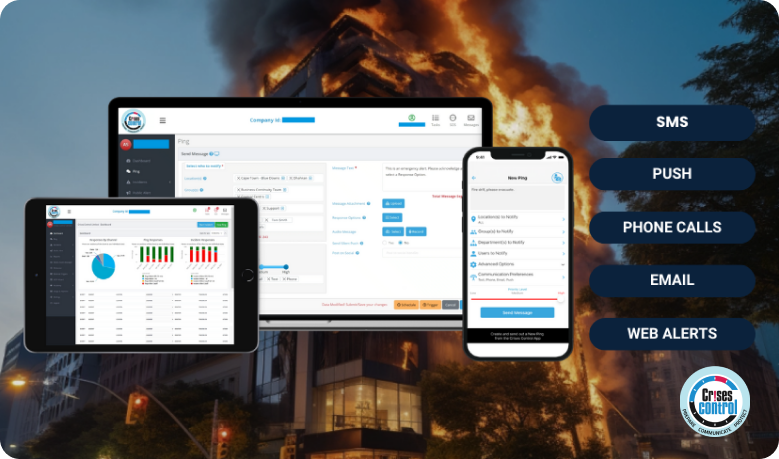In the fast-paced world of business, unexpected emergencies can strike at any moment, leaving organisations scrambling to respond. Imagine a scenario where a crisis unfolds, catching everyone off-guard. Communication breaks down, chaos ensues, and critical time slips away. But there’s a solution amidst the chaos: the Emergency Mass Notification System (EMNS). Welcome to our comprehensive guide, where we dive into the ins and outs of an Emergency Mass Notification System, explore its benefits, provide practical advice on selection and implementation, and showcase how Crises Control can revolutionise crisis management into a proactive, efficient process.
What is an Emergency Mass Notification System?
An Emergency Mass Notification System is a robust platform designed to disseminate critical information swiftly to a large group of people during emergencies or crisis situations. Whether it’s a natural disaster, a security breach, or any unforeseen event requiring urgent action, an EMNS serves as a lifeline, connecting authorities with individuals and teams, both within and outside an organisation.
How Does an Emergency Mass Notification System Work?

At its core, an EMNS operates on a simple yet powerful principle: rapid dissemination of information through multiple channels. From SMS and emails to mobile apps and social media, modern EMNS leverage various communication channels to reach recipients wherever they are, ensuring no one misses critical alerts.
In essence, when an emergency occurs, authorised personnel can trigger alerts through the EMNS platform, which then delivers messages to predefined groups or individuals in real-time. This ensures swift action and coordination, minimising potential damage and maximising safety.
The Benefits of Using an Emergency Mass Notification System
- Speed and Efficiency: EMNS enables organisations to communicate urgent information rapidly, reducing response time and enhancing overall crisis management.
- Enhanced Safety and Security: By keeping employees, customers, and stakeholders informed during emergencies, EMNS contributes to a safer environment and minimises risks.
- Improved Coordination: With features like two-way communication and geotargeting, EMNS fosters seamless collaboration and coordination among response teams, ensuring a cohesive response to crises.
- Compliance and Regulations: Many industries have stringent compliance requirements regarding emergency preparedness. Implementing an EMNS helps organisations meet these standards and demonstrate their commitment to safety.
How to Select an Emergency Mass Notification System
Choosing the right EMNS is crucial for ensuring effective crisis management. Here are key factors to consider:
- Scalability: Ensure the EMNS can scale with your organisation’s growth and evolving needs.
- Ease of Use: Look for an intuitive interface and user-friendly features to facilitate quick adoption and usage during emergencies.
- Integration Capabilities: Evaluate whether the EMNS integrates seamlessly with your existing systems and communication channels.
- Customisation Options: Seek a solution that allows customisation of alerts, recipient groups, and escalation procedures to align with your organisation’s specific requirements.
- Reliability and Redundancy: Choose an EMNS provider with robust infrastructure and redundant systems to ensure uninterrupted service, even during network disruptions.
Key Features of an Effective Mass Notification System
- Multi-Channel Delivery: The ability to send alerts via SMS, voice calls, email, mobile apps, and social media ensures maximum reach and engagement.
- Two-Way Communication: Enable recipients to respond to alerts, providing valuable feedback and confirming their safety status.
- Geotargeting: Deliver location-specific alerts to individuals based on their proximity to the crisis, ensuring relevant information reaches the right people.
- Automation and Scheduled Alerts: Automate alert triggers and schedule notifications in advance to streamline communication workflows.
- Reporting and Analytics: Access real-time data on alert delivery, recipient responses, and overall system performance to assess effectiveness and make informed decisions.
Why Prioritise Testing and Training with an Emergency Mass Notification System
Testing and training are vital components of emergency preparedness. Regular drills and exercises ensure that all stakeholders are familiar with the EMNS platform, understand their roles and responsibilities during emergencies, and can respond effectively when the need arises. Moreover, testing helps identify any gaps or issues in the system, allowing for timely improvements and optimisations.
Best Practices for Implementing an Emergency Mass Notification System
- Develop a Comprehensive Communication Plan: Outline protocols for alerting, escalation, and response, ensuring clarity and consistency during crises.
- Educate and Train Employees: Provide ongoing training to employees on how to use the EMNS effectively and what actions to take during emergencies.
- Regularly Update Contact Information: Maintain up-to-date contact lists to ensure accurate and timely delivery of alerts.
- Conduct Drills and Exercises: Practice using the EMNS through simulated scenarios to evaluate readiness and identify areas for improvement.
- Review and Improve: Continuously assess the effectiveness of your EMNS implementation and make adjustments as needed to enhance performance and reliability.
How Can Crises Control Help?

At Crises Control, we understand the critical importance of effective crisis management. Our comprehensive Emergency Mass Notification System empowers organisations to communicate swiftly and decisively during emergencies, ensuring the safety and well-being of all stakeholders. With features like multi-channel delivery, two-way communication, and robust reporting, Crises Control is your trusted partner in crisis preparedness.
Contact us today to schedule a free demo and discover how Crises Control can help your organisation navigate crises with confidence.
Conclusion
In conclusion, investing in an Emergency Mass Notification System is not just a prudent business decision, but a moral imperative in today’s uncertain world. By prioritising preparedness, organisations can mitigate risks, safeguard lives, and emerge stronger from any crisis that may arise.
Remember, the key to effective crisis management lies in proactive planning, robust communication, and the right tools at your disposal. With Crises Control by your side, you can face any challenge with resilience and resolve.
Request a FREE Demo
Interested in our Emergency Mass Notification System?
FAQs
1. What is an Emergency Mass Notification System (EMNS)?
An EMNS is a robust platform designed to swiftly disseminate critical information to a large group of people during emergencies or crisis situations.
2. How does an Emergency Mass Notification System work?
An EMNS operates by triggering alerts through a centralised platform, which then delivers messages via various communication channels such as SMS, email, mobile apps, and social media in real-time.
3. What are the benefits of using an Emergency Mass Notification System?
Using an EMNS enhances speed and efficiency in crisis communication, improves safety and security, fosters better coordination among response teams, and ensures compliance with regulations.
4. How can organisations select the right Emergency Mass Notification System?
Organisations should consider factors such as scalability, ease of use, integration capabilities, customisation options, and reliability when selecting an EMNS that aligns with their specific needs.
5. Why is testing and training important for Emergency Mass Notification Systems?
Testing and training ensure that all stakeholders are familiar with the EMNS platform, understand their roles during emergencies, and can respond effectively. Regular drills help identify any gaps or issues in the system, allowing for timely improvements.
